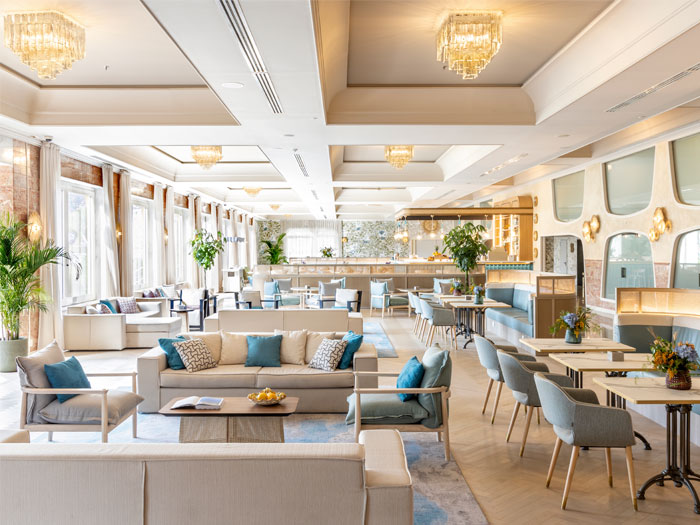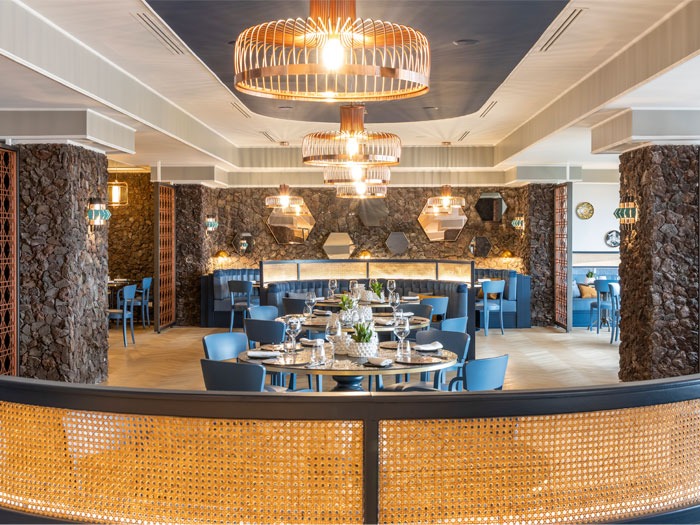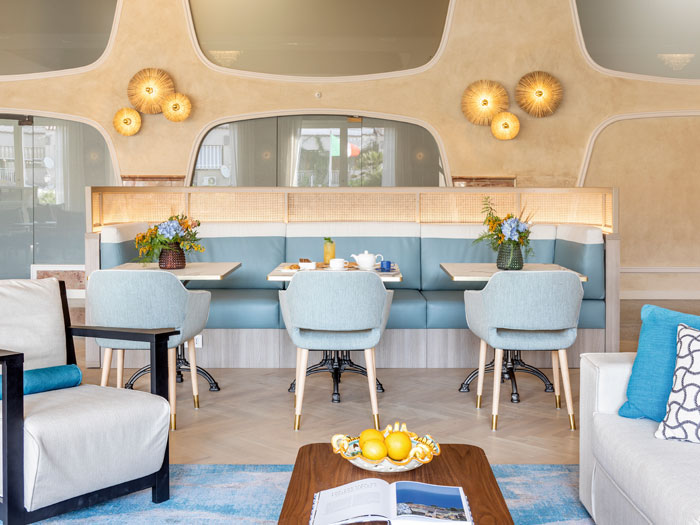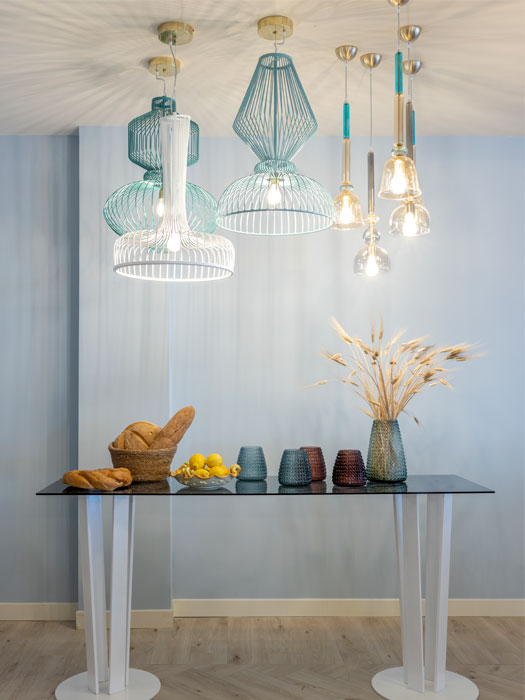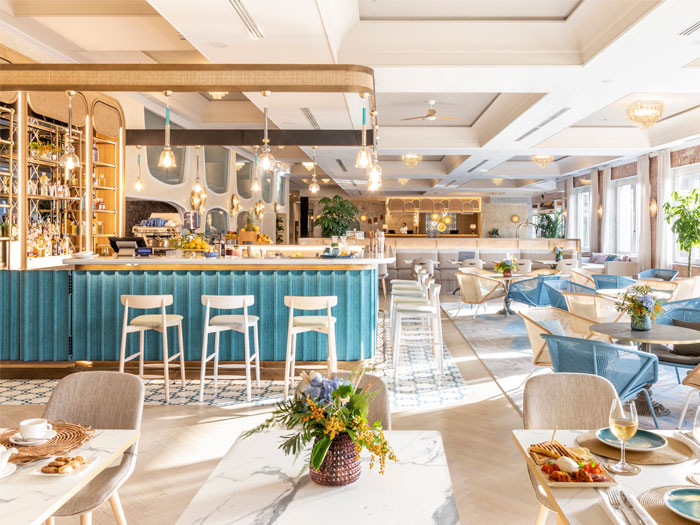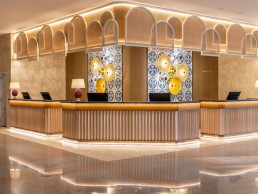
RG Naxos Hotel, Sicily
THDP’s Nicholas J Hickson sits down with Editor Sarah Cullen to discuss the design influences for the RG Naxos Hotel at Giardini Naxos in Sicily. The scheme takes strong aesthetic cues from the towering Mount Etna located above the resort.
RG Naxos Hotel at Giardini Naxos, Sicily, has recently opened and is set to become a new Delta Hotel by Marriott. Designers THDP were brought on board at the end of 2019 to complete the new scheme for the hotel that was previously built in the late 1970s. Huddled against the Mediterranean coast and cradled by the imposing Mount Etna, the hotel’s position is idyllic and unique. The hotel features 296 guest rooms, suites, two penthouses, two restaurants, lobby, gardens and beach, all of which were designed by THDP.
darc caught up with lead designer Nicholas J Hickson to find out more about the chosen aesthetics and their inspiration.
“The hotel was first built back in the late 70s as a Holiday Inn, so the rooms and hotel are therefore atypically large for the area; the hotel was then a Hilton Hotel – but has now rebranded as a Delta Hotel by Marriott. The client is an Italian family, which owns many other hotels in Rome, Milan and other areas of Sicily,” explains Hickson.
Mount Etna and its volcanic landscapes played a key role in the team’s design concept and choices for materials and objects throughout the space. Its natural beauty and supernatural presence, along with the nautical, seaside features of the island of Sicily, were brought together into a central point of design in the lobby. By adding local decoration, artworks and colours, the goal was to add character, a deep sense of authenticity and a refined and resort-based palette of natural tones with touches of colours of the sea.
What made this a stand-out project for the team, was its location. “Being in the shadow of Mount Etna, gave us a real opportunity to tell stories – La Sciara restaurant in particular features dark grey rough lava stone walls, and enameled lava stone bar and tables – the theme is dark, brooding just like the volcano above it,” says Hickson.
The hotel is also categorised as a MICE hotel for meetings, incentives, conferences and exhibitions. It provides an elite space for professionals in a tailor-made hospitality setting.
From the outset, THDP considered adding a new lobby bar to the centre of the space, defined as being both a visual anchor but also dividing the space and making it feel more intimate. This new layout allows workers and leisure guests to cohabit in an intimate space. The style is elegant, Mediterranean with sea colours and Taormina’s stone colours blending the indoors and outdoor colour palettes.
In terms of lighting this space, Hickson says: “The lobby area for the hotel is very large, and previously didn’t have an anchor feature, to encourage guests to use it. A very early idea from THDP, supported by the client, was to activate this space as a new lobby bar, Quintessenza. Therefore, the lighting needed to be completely manageable to transition the space from a fresh place to have a coffee, to a cool cocktail bar in the evening. We built lighting into and over the bar and added lighting to the back of some new banquet seating, which had a room divider effect with a rattan screening and new Laos wall lights were added by Aromas del Campo. These are a wonderful collection of dried grass wheels, which are back lit – perfect for a seaside resort. Overhead fans were also added to give a cooling and peaceful atmosphere.
“For us, lighting not only provides a functional but aesthetic enhancement to any space, so as this was a MICE hotel used by both business and leisure guests it was important to light the spaces well, but also to enhance each area,” explains Hickson. “Generally, the meeting rooms have recessed ceiling lighting, with inset LEDs so the lighting is invisible but completely manageable. For the restaurant here too, the lighting was generally lowered, and new pieces of furniture, such as buffets etc. had built-in lighting at touch points to help guests navigate.
“The decorative lighting brands we chose included: Aromas del Campo, Faro Barcelona, Utu Lighting, Marset, Aldo Bernadi, Contardi, Servomuto.”
Speaking of how the lighting was integrated into the entire interior design and what it brings to the spaces, Hickson says: “Without good lighting there is no interior, ensuring that there is not only light but there is dark is the key for us, allowing spaces to transition from daytime use to evening is so important to our front of house spaces. So lighting placement and control is key. Too much lighting, or lighting in the wrong space simply ruins a good design.”
As is the case with so many projects these days, the THDP inevitably encountered some issues with completing this design during international lockdowns, which caused numerous delays throughout the process.
“The client initially wanted the interiors of the main front of house areas built during the spring of 2020, THDP were appointed in December 2019. With Covid rather interfering with this plan the works were finally carried out in the autumn of 2020 and spring 2021. Clearly the intent of the interior design being in such a wonderful location as Sicily was to keep the design, selection of suppliers and finishes local. This way we could rely on the natural heritage of these materials within our design.
“Like everyone else THDP soon became fluent in meeting online, of course this affected the review meetings, luckily we have a team placed in Italy so we could always attend meetings personally and review samples and materials with the client directly. Of course we prefer to meet the client face to face, and we now recognise that by doing so, you really avoid misunderstandings, and you can not just show your work to your client but get immediate feedback from them. Moving forward we will revert back to meeting clients face to face.”
Luckily for the design teams, the brief for the concept did not change over the course of the project. However, as is typical, the budget did “mature over time”, and due to the age of the building, necessary additional costs came into play to cover civil works that had not originally been accounted for. “Some value engineering took place, but in the end it was through direct procurement opportunities that savings were made – and therefore in the end many of the items specified by THDP were included,” says Hickson.
Overall, the final outcome of the design is something Hickson and the team are “immensely proud of” despite working with the challenges brought on by Covid-19. “I think if we had the opportunity to visit the property more we would have had a better result, as the project was more or less completely designed in lockdown, it suffered due to obvious misunderstandings, which caused some delays – that said, we are immensely proud of the final result.
“I think the balance of using a local design vernacular mixed with a modern take on interior design works really well, not making it kitsch, but rethinking local tradition and making it feel more contemporary – perhaps given more time it would have been possible to add more artwork, and accessories to amplify this,” he concludes.



